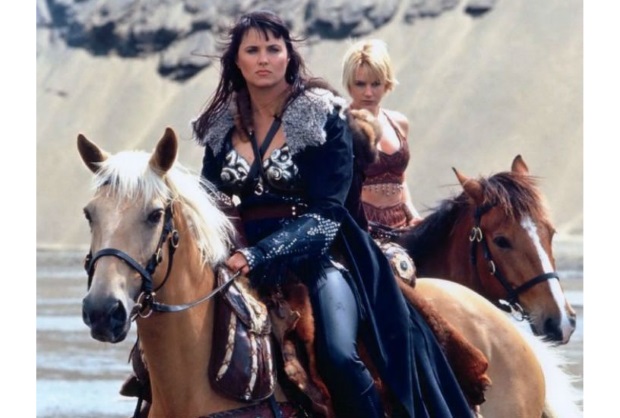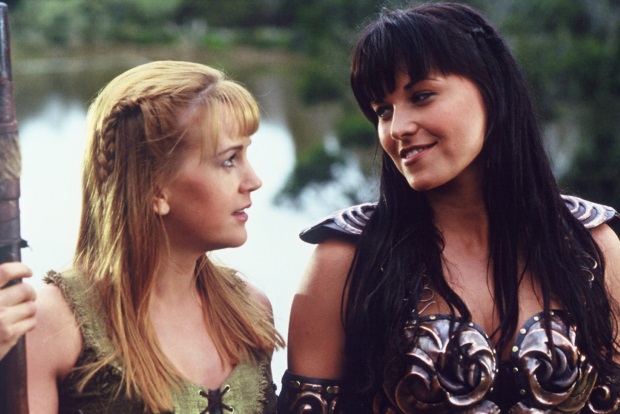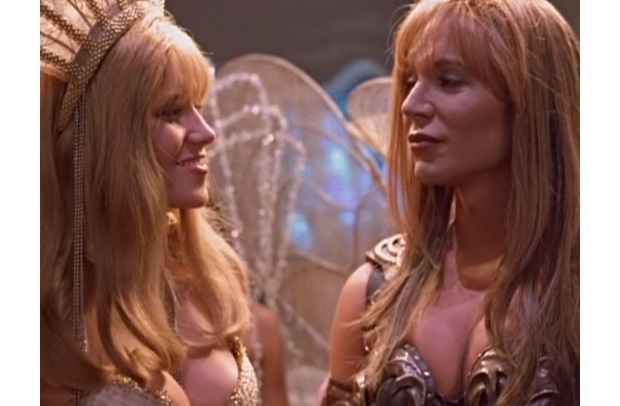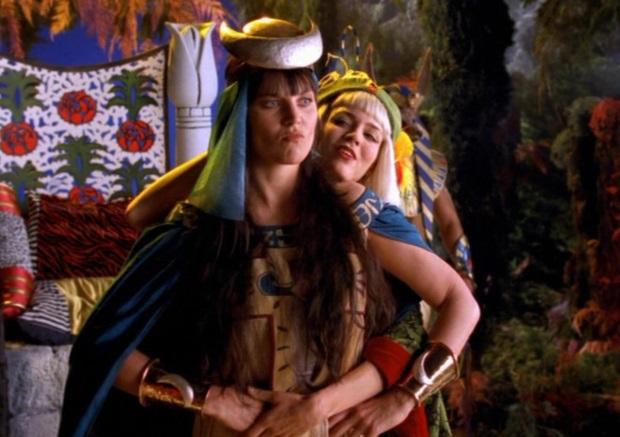Why Xena: Warrior Princess Was Groundbreaking
Xena: Warrior Princess, starring Lucy Lawless, was a breath of fresh air in the '90s sci-fi and fantasy TV landscape...
If you remember Xena: Warrior Princess, you probably do for a few reasons. The tiny, tight-fitting costumes worn by its lead characters. That circular spinny thing Xena threw at people (it’s called a chakram). Xena’s fabulous ululating war cry. The bizarre mish-mash of history the show threw together (though the producers knew their stuff, deep down – Rob Tapert later produced the rather more accurate Spartacus for STARZ). What you might not remember, or might not know if you’re unfamiliar with the show, is just how important and ground-breaking Xena was when it first aired between 1995 and 2001.
The first and most obviously groundbreaking thing about Xena: Warrior Princess was, of course, the gender of its lead character. Xena wasn’t the first female lead of an action-adventure series – Charlie’s Angels and Lynda Carter’s Wonder Woman, for example, had enjoyed success in the 1970s, while non-action-adventure shows led by women had been common for quite some time, with 1990s examples including Ellen, Blossom, Sabrina the Teenage Witch, and Cybill.
The way Xena presented its female hero, though, was a bit different. The opening narration describes how “a land in turmoil cried out for a hero” and then presents the hero in question with an emphatic “she” as we see Xena riding into battle. Lucy Lawless, aside from being likable and charismatic, gave us a heroine who looked like she could physically handle a fight (rather than a super-powered waif-like heroine) while still being extremely attractive (as the costume department and directors were keen to emphasize!). She owed a lot to Carter and Wonder Woman, but Xena’s capability, confidence, and independence were a breath of fresh air in the 1990s SFF television landscape.

Xena’s portrayals of race, gender, and sexuality may seem fairly normal or even disappointing now but were highly progressive at the time. While the show was white-dominated, there was a clear effort made to introduce a more diverse cast. One of Xena’s early love interests was a black man, something hopefully no longer of note, but still relatively unusual at the time. The show also cast a black actress, Galyn Görg, as Helen of Troy, the most beautiful woman in the world, offering a nice change from the usual blonde, blue-eyed Helens we’ve seen on film and TV for decades. Similarly, Cleopatra was later played by Gina Torres. The series also set several episodes in Asia, featuring Asian guest characters.
The most significant relationship on Xena was, of course, that between Xena and Gabrielle. To a modern viewer, their relationship probably comes across as frustrating and disappointing, as despite many hints, frequent sub-textual references, and great chemistry between the two actresses, their relationship was never officially clearly stated to be romantic. They did, however, kiss as early as season 2.

Back in the 1990s, two characters of the same gender kissing was still a huge deal. Carol and Susan on Friends were restricted to hugging even at their wedding, while Willow and Tara’s first on-screen kiss on Buffy the Vampire Slayer was eventually worked into the deeply emotional episode “The Body,” after almost two years of subtext and more hugging.
On Xena, in the grand tradition of SFF TV (see also: Star Trek‘s “Plato’s Stepchildren”), a way was found to make the kiss more palatable to the networks. Xena was occupying the body of a man, Autolycus, at the time, so we see Xena’s spirit and Gabrielle’s come together for the kiss, played by the actresses, and then cut to Renee O’Connor’s Gabrielle kissing Bruce Campbell’s Autolycus, so the image actually broadcast is that of a man and a woman kissing. This may look like pandering and queer-baiting to modern eyes, but for the 1990s, it was a major step forward and the kiss was hugely important to LGBTQ Xena fans. Throughout the series, tricks like this were used to create a romantic story by the back door, so to speak. In another plot arc, Xena and Gabrielle’s reincarnated souls married each other.
Both characters had relationships with men throughout the series as well, but a reading of the show as led by two bisexual female characters who were in a relationship with each other was positively encouraged by numerous hints. In 1997, the same year as Xena and Gabrielle’s kiss, both Ellen DeGeneres and her namesake character on her own sitcom came out, something which sent shock waves through the entertainment industry, so this was a genuinely progressive move. And Xena told progressive stories about gender in other ways as well. Also in 1997, the episode “Here She Comes… Miss Amphipolis” featured a transvestite character winning a beauty pageant (in which Gabrielle acts as Xena’s “sponsor,” surrounded by men “sponsoring” their girlfriends).

Xena was groundbreaking in its format as well. Like contemporary show Frasier, Xena was a spin-off based on a character from another series and this produced a setup that might not have sold without its head start from Hercules: The Legendary Journeys. Our hero is not a pure and innocent champion of good, but a former villain trying to redeem herself for the bad things she’s done (this may sound familiar, but remember, the show pre-dates Angel!). This setup ensures that Xena never slips into standard Strong Female Character tropes. Strong she certainly is, but she is also fully three-dimensional, flawed (always trying to balance violent impulses and a desire for peace), looking for ways to use her violent skills for good and burdened by guilt. And then there’s her counterpart, Gabrielle – resisting physical violence for a long time, interested in art and literature but unable to tear herself away from Xena and the violence inherent in Xena’s lifestyle.
The show also popularized some of modern SFF television’s most beloved tropes. It was not the first show to break the fourth wall, or do a musical episode, or do a time loop episode, or any of the other tropes that show up. However, it did do a lot to popularize more experimental episodes like “A Day In The Life” or the famous first musical episode “The Bitter Suite” – which took the musical format completely seriously, a move unusual at the time – as the show used these in a manner and with a frequency that were unusual at the time (along with its parent show, Hercules).
The X-Files, for example, produced some great format-bending episodes, but usually only once or twice a season (with the exception of season six). Xena showed that a series format could be seriously flexible, including multiple episodes set in the twentieth century, hundreds of years away from the main setting of the show, as well as a wide range of other stories. Again, it was not the first or the only show to do so (Doctor Who is the most obvious example of a show with a seriously flexible format) but it made this type of television seem viable and popular.

Xena has had a huge influence on SFF film and television over the years. It takes only a brief look at a basic description of the show to see how much Buffy the Vampire Slayer (which debuted as a television series two years after Xena, in 1997, though the 1992 film pre-dates Xena) and Angel owe to Xena, and the debt was acknowledged in Buffy’s “Halloween” (“She couldn’t have dressed up like Xena?”).
It’s also worth noting that, before The Lord of The Rings showed the world how beautiful the New Zealand landscape was, the cast and crew of Xena and Hercules were ignoring the distinct lack of any similarity between the geography of New Zealand and Greece and showing the scenery off as best they could on relatively low budget television. Many of the cast and crew worked on the Lord of the Rings films as well – notable examples include cast members Karl Urban and Martin Csokas, costume designer Ngila Dickson (whose departure in 1999 presumably allowed her to focus on the films), and Richard Taylor and Tania Rodger, co-founders of Weta Workshop, who worked on a handful of early episodes.
In some ways, Xena: Warrior Princess hasn’t aged too well. The special effects can look a bit ropey (not surprising considering the show’s era and budget), the stories are often cheesy, and its episodic format has gone out of fashion. But the show is well worth a watch if you haven’t yet caught an episode. It has heart and heap-loads of humor (every episode ends with a joke disclaimer about who was or was not harmed during the making of it) and managed to balance dark and light pretty well, veering between pure comedy and deeply serious material with relative ease. The current SFF TV landscape wouldn’t be what it is without Xena and her chakram.
